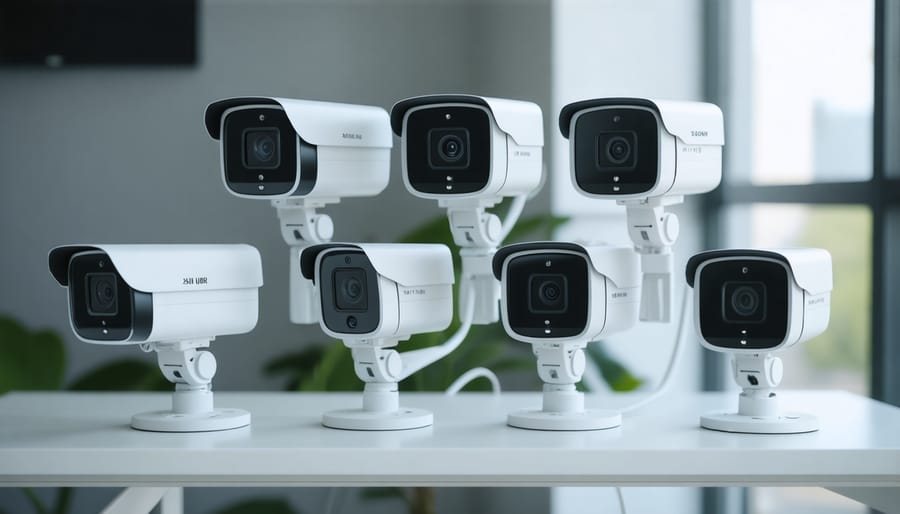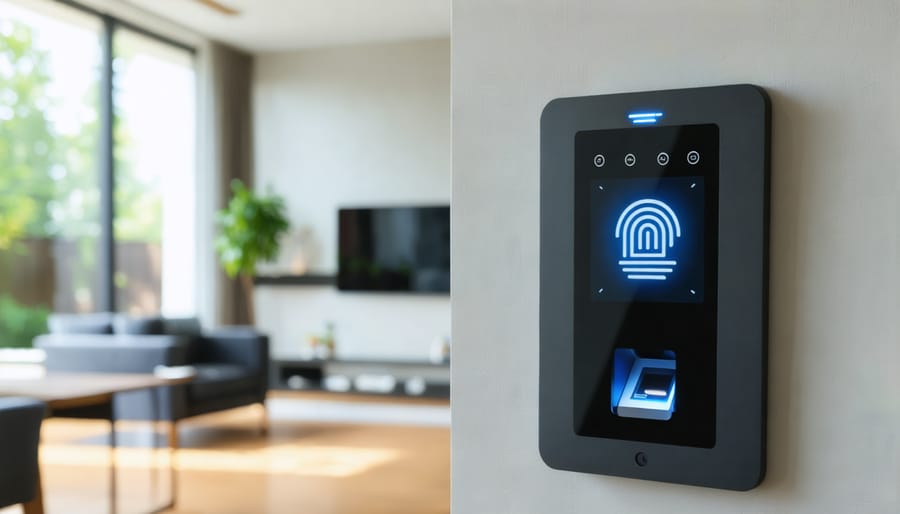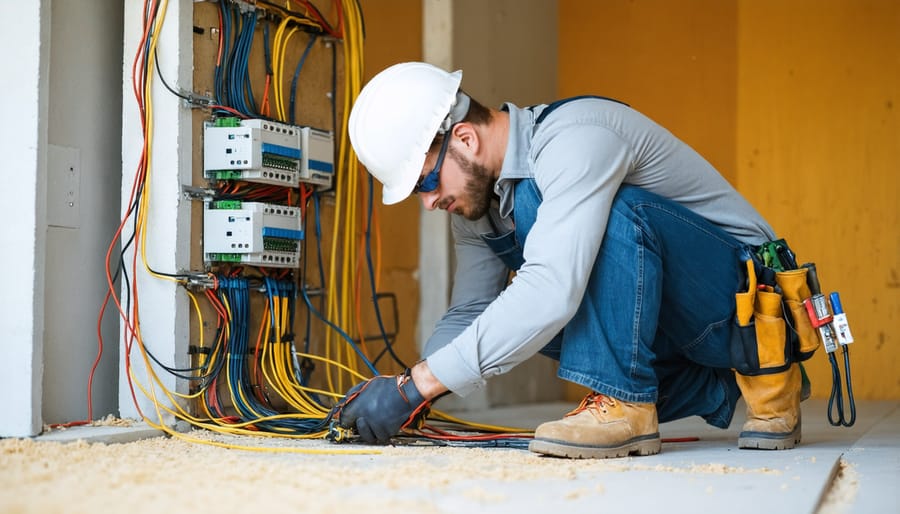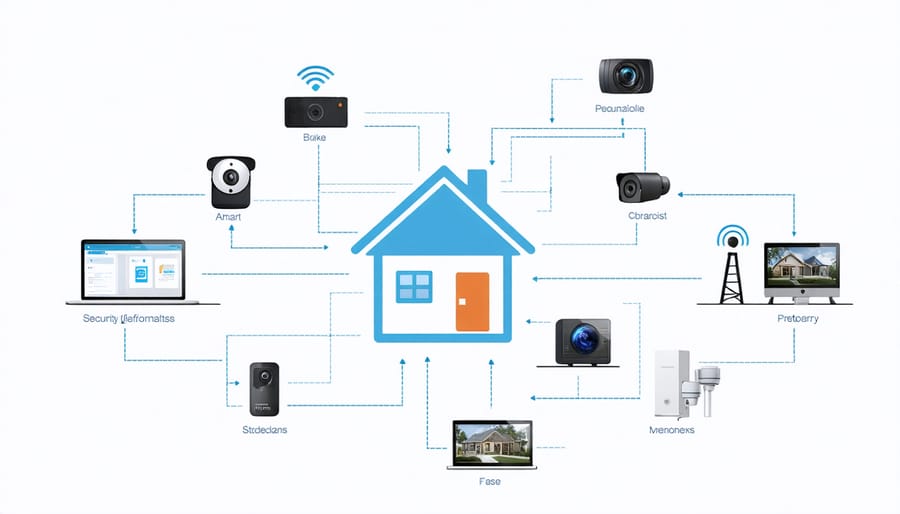Selecting the optimal smart home security system demands rigorous evaluation of integration capabilities, scalability requirements, and compliance standards that directly impact construction specifications. Modern smart home features have fundamentally transformed security infrastructure requirements, necessitating careful consideration of network architecture, power distribution systems, and emergency response protocols during the construction phase. Professional-grade security solutions must seamlessly integrate with building management systems (BMS) while meeting stringent industry certifications and local building codes. For construction professionals, the selection process extends beyond basic functionality to encompass critical factors such as wire-free vs. hardwired installation requirements, backup power systems, and physical infrastructure modifications needed to support comprehensive security coverage. This technical analysis examines enterprise-level security solutions specifically engineered for new construction and major renovations, focusing on systems that deliver maximum ROI while ensuring compliance with both current standards and future-proof specifications.
Modern Security System Components: A Professional Analysis
Advanced Video Surveillance Integration
Modern video surveillance integration has evolved significantly beyond basic CCTV systems, incorporating advanced AI capabilities that align with critical infrastructure security standards. Professional-grade camera systems now feature machine learning algorithms capable of distinguishing between routine activity and potential security threats, dramatically reducing false alarms while enhancing detection accuracy.
When implementing these systems, construction professionals must consider several key factors. The placement of cameras requires careful analysis of sight lines, lighting conditions, and potential environmental interference. High-resolution cameras (minimum 4K) should be positioned strategically at entry points, perimeters, and vulnerable areas, with appropriate overlapping coverage to eliminate blind spots.
Network infrastructure must support the substantial bandwidth requirements of modern surveillance systems. Category 6a or fiber optic cabling is recommended for optimal performance, particularly when implementing features like facial recognition or license plate detection. Storage considerations are equally crucial, with most systems requiring secure, redundant storage solutions capable of handling large volumes of high-definition footage.
Integration with other smart home security components is essential for maximum effectiveness. Modern systems should interface seamlessly with access control systems, motion sensors, and home automation platforms through standardized protocols like ONVIF. This integration enables coordinated responses to security events and provides comprehensive monitoring capabilities through unified management interfaces.


Access Control Systems
Modern access control systems form a critical component of smart home security, combining sophisticated biometric authentication with advanced digital protocols. Biometric systems, including fingerprint scanners and facial recognition technology, offer unprecedented security levels while maintaining operational efficiency. These systems typically achieve a 99.9% accuracy rate and can process authentications within 0.3 seconds.
Smart locks have evolved to incorporate multiple authentication methods, including PIN codes, mobile credentials, and biometric verification. Leading manufacturers now offer systems that integrate seamlessly with building management platforms, enabling centralized control and monitoring. These solutions can manage up to 5,000 unique user credentials and maintain detailed access logs for security auditing.
Integration with building management systems (BMS) allows for comprehensive control over entry points, elevators, and restricted areas. Advanced APIs enable real-time communication between access control systems and other security components, such as surveillance cameras and intrusion detection systems. This integration creates a unified security ecosystem that responds intelligently to potential threats.
For construction professionals, selecting an access control system requires careful consideration of scalability and compatibility with existing infrastructure. Modern systems support various communication protocols, including BACnet and Modbus, ensuring seamless integration with building automation systems. The implementation should also account for future expansions and technological updates, with modular designs that allow for easy upgrades without significant infrastructure changes.
Top-Rated Professional Security Systems for 2024
System Performance Metrics
When evaluating smart home security systems, performance metrics serve as crucial benchmarks for system effectiveness and reliability. Professional-grade systems typically demonstrate response times of under 10 seconds from trigger to notification, with premium solutions achieving responses within 3-5 seconds. This rapid response capability is essential for construction projects where immediate threat detection and notification are paramount.
System reliability is measured through multiple parameters, including uptime percentage, backup power duration, and fault tolerance. Industry-leading systems maintain 99.99% uptime, with redundant cellular and Wi-Fi connections ensuring continuous operation even during network outages. Professional-grade backup power systems typically provide 24-48 hours of autonomous operation, meeting critical security requirements for commercial and high-end residential installations.
Integration capabilities vary significantly across platforms, with enterprise-level systems supporting standard protocols such as Z-Wave, Zigbee, and REST APIs. These systems can typically manage 100+ connected devices simultaneously while maintaining stable performance. Leading platforms demonstrate compatibility with building management systems (BMS) and support IFTTT (If This Then That) programming for advanced automation scenarios.
Data transmission rates and storage capabilities are equally important considerations. High-performance systems support 4K video streaming with H.265 compression, requiring 5-10 Mbps per camera while maintaining optimal frame rates. Cloud storage solutions offer scalable capacity, typically retaining 30-90 days of footage with enterprise-grade encryption.
False alarm rates serve as a key performance indicator, with advanced systems achieving rates below 1% through AI-powered verification and multiple sensor cross-referencing. This sophisticated approach significantly reduces unnecessary emergency response dispatches and associated costs.
System scalability metrics indicate that enterprise-grade solutions can effectively manage up to 500 sensors and 64 cameras per control panel while maintaining consistent performance. Load testing reveals that well-designed systems handle simultaneous triggers from multiple devices without degradation in response time or notification delivery.
Installation Requirements and Infrastructure
When implementing a smart home security system, proper infrastructure planning is crucial for optimal performance and reliability. The foundation begins with a robust electrical system capable of supporting continuous operation. A dedicated 20-amp circuit is recommended for the main control panel and core components, while auxiliary devices may require additional circuits depending on power consumption requirements.
Network infrastructure demands careful consideration, with Cat6 or Cat6a ethernet cabling recommended for primary components to ensure stable connectivity and future-proofing. Strategic placement of wireless access points helps maintain consistent coverage for Wi-Fi-dependent devices, typically requiring one access point per 1,500 square feet of coverage area.
Structural modifications may be necessary for installing outdoor cameras, motion sensors, and entry point protection. Weather-resistant conduit installation for exterior wiring requires proper sealing and drainage considerations. When mounting security cameras, load-bearing capacity must be verified, particularly for heavy PTZ (Pan-Tilt-Zoom) units that can weigh up to 15 pounds.
For retrofit installations, accessing wall cavities and running new wiring paths often requires strategic planning to minimize aesthetic impact. Consider installing wire molds or crown molding with integrated cable channels where necessary. Junction boxes should be positioned in accessible locations for future maintenance while remaining concealed from view.
Backup power systems are essential for maintaining security during outages. A properly sized UPS (Uninterruptible Power Supply) system should support critical components for a minimum of 4-6 hours. For comprehensive protection, consider installing a whole-house generator with automatic transfer switch capabilities.
Environmental factors affect component placement and protection requirements. Security cameras and sensors must be positioned away from direct sunlight and protected from moisture intrusion. Temperature-controlled spaces are necessary for main control panels and recording equipment, with ambient temperatures maintained between 50-85°F (10-29°C) for optimal performance.
Professional installation should comply with local building codes and security industry standards, including proper grounding, surge protection, and fire-rated penetrations where required.


Integration with Building Management Systems
Automation and Control Protocols
In the professional security integration landscape, the selection of automation and control protocols significantly impacts system reliability and scalability. Industry leaders predominantly utilize Z-Wave and Zigbee protocols, with Z-Wave offering superior range and reliability in construction environments. These protocols operate on separate frequencies from Wi-Fi, minimizing interference and ensuring consistent performance across larger installations.
Modern security systems must integrate seamlessly with building management systems (BMS) through standardized protocols such as BACnet or Modbus. This integration enables centralized control and monitoring while maintaining compliance with construction industry standards. When specifying security components, ensure compatibility with these protocols to facilitate future expansions and minimize integration challenges.
Matter protocol, the newest industry standard, presents promising opportunities for cross-platform compatibility. This protocol enables security devices from different manufacturers to communicate effectively, reducing dependency on proprietary systems. For construction professionals, this translates to greater flexibility in component selection and simplified system architecture.
API accessibility is another crucial consideration, particularly for custom integrations with access control systems and video management software. RESTful APIs have become the de facto standard, allowing for secure, reliable communication between different system components. When evaluating security solutions, verify the availability of well-documented APIs and ensure they align with your project’s integration requirements.
For optimal performance, implement redundant communication paths and ensure all protocols support robust encryption standards, such as AES-128 or higher.
Energy Management Integration
Modern smart home security systems serve as a crucial component in comprehensive energy efficiency systems, offering significant advantages beyond traditional security functions. Through integrated automation and intelligent sensors, these systems can automatically adjust HVAC settings, lighting controls, and power distribution based on occupancy patterns and security status.
When the security system detects that residents have left the premises and armed the system, it can trigger automated responses such as adjusting thermostats to economical settings, shutting off unnecessary lighting, and powering down non-essential equipment. This integration typically results in 15-30% reduction in energy consumption across residential properties.
Advanced security platforms incorporate machine learning algorithms that analyze historical usage patterns to optimize energy management. For instance, motion sensors used for security surveillance can double as occupancy detectors for smart climate control, while window sensors can alert HVAC systems to modify output when detecting open windows or doors.
Professional integration of security and energy management systems requires careful consideration of communication protocols and hardware compatibility. Leading manufacturers now support standard protocols like Zigbee and Z-Wave, enabling seamless integration with building management systems (BMS) and ensuring scalability for future expansions. This convergence of security and energy management creates a more efficient, cost-effective building operation while maintaining robust security standards.
Future-Proofing Considerations
When designing a smart home security system, future-proofing smart homes becomes crucial for long-term viability and return on investment. Industry experts recommend implementing systems with modular architectures that allow for component upgrades without complete system overhauls.
Key considerations include selecting security platforms that support open protocols like Z-Wave, Zigbee, and Matter. These standards ensure compatibility with future devices and reduce dependency on proprietary technologies that may become obsolete. Infrastructure planning should incorporate adequate bandwidth capacity and power supply systems that can accommodate additional sensors, cameras, and smart devices.
Scalability remains paramount in system design. Security infrastructure should include extra conduit space, strategic placement of power outlets, and network connection points to facilitate future expansions. Professionals recommend installing category 6A or higher ethernet cabling and implementing robust wireless mesh networks to support increasing data demands.
Cloud integration capabilities deserve particular attention, as remote monitoring and artificial intelligence-driven analytics continue to evolve. Systems should feature APIs and SDKs that enable integration with emerging technologies, such as advanced biometrics, autonomous drones, and predictive security algorithms.
Physical infrastructure considerations include:
– Dedicated electrical circuits with surge protection
– Backup power systems with smart battery management
– Multiple communication pathways for system redundancy
– Weather-resistant enclosures for outdoor components
– Expandable control panels with modular card slots
Cybersecurity measures must evolve with emerging threats. Implementation of end-to-end encryption, regular firmware updates, and secure authentication protocols helps protect against future vulnerabilities. Professional integrators should establish clear upgrade paths and maintenance schedules to ensure system longevity.
Construction professionals should also consider environmental sustainability and energy efficiency in their security system designs. Components should be selected based on their energy consumption profiles and potential for integration with smart building management systems. This approach ensures that security solutions contribute to overall building performance while maintaining operational effectiveness.
Remember to document all system specifications, network configurations, and expansion capabilities thoroughly. This documentation becomes invaluable for future modifications and ensures smooth transitions during system upgrades or expansions.
When selecting a smart home security system for construction projects, several key factors emerge as critical decision points. The integration capabilities, scalability, and compliance with building codes should be primary considerations for any construction professional. Based on our analysis and industry expert feedback, systems that offer open API architecture and support multiple communication protocols provide the most flexibility for future expansions and modifications.
For new construction projects, we recommend implementing comprehensive solutions that integrate seamlessly with building management systems (BMS) and can be easily incorporated during the construction phase. The ADT Commercial and Honeywell Enterprise solutions have demonstrated exceptional reliability and compatibility with modern building infrastructure, while Control4 offers superior integration capabilities for luxury residential developments.
Professional installation remains crucial for optimal system performance and warranty compliance. However, the system should be designed with maintenance accessibility in mind, allowing for future updates and modifications without major structural interventions.
Cost considerations should extend beyond initial installation to include long-term maintenance, monitoring services, and potential upgrade requirements. Our case studies indicate that systems with modular architectures typically offer the best return on investment over the building’s lifecycle.
For construction professionals, we recommend prioritizing systems that offer:
– Enterprise-grade encryption and cybersecurity features
– Compatibility with common building automation protocols
– Robust remote management capabilities
– Comprehensive technical support and documentation
– Scalable architecture for future expansion
Remember that the best security solution will vary based on project specifications, client requirements, and local regulations. Always conduct a thorough site assessment and consult with security integration specialists during the planning phase to ensure optimal system design and implementation.

